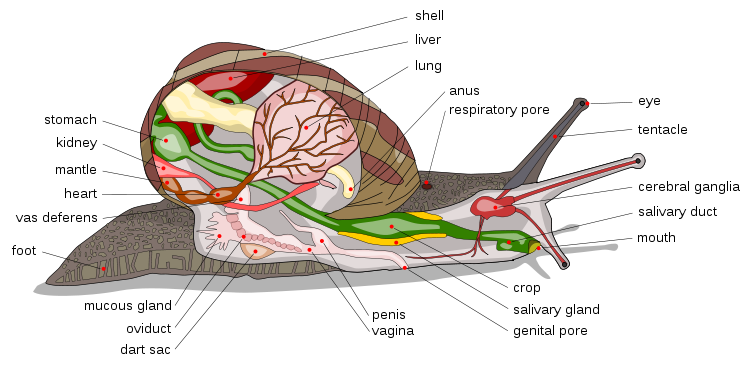
Adaptation
Teeth
As described in its common name, Chisos liptooth, this species has many teeth and lamellae used as barriers in the aperture to prevent attacks from predators such as beetles (Dourson, 2006).These specialized teeth can also be used to store calcium for repairing its damaged shell or for balance during movement (Dourson, 2006).
Shell
Daedalochila are distinct because in their outer lip there's an inwardly bent concave ledge which ends at its lower edge (Cheatum, 1971). There is also a presence of a tubercle not that far away from the opening of the shell (Cheatum, 1971). The opening of its mouth is sharply angled (Pilsbry, 1940). Chisos liptooth's shell has about five whorls and is between 9.5mm and 14.2mm in width (Burch, 1962). The first whorl is smooth while the rest have low and unequal ripples of growth showing (Pilsbry, 1940). A glossy but slightly translucent shell with a pale brown color best describes the look of the snail at first sight (Burch, 1962). The color of the shell is probably used to blend into its environment and avoid predation.
The very first thing a person would notice about a snail would probably be its shell. This shell is made of calcium carbonate and is classified as an exoskeleton (Hickman et al., 2009). Exoskeletons are used in gastropods as protection from evaporation and the surrounding environment; its is likely that Daedalochila chisosensis use it for the same purposes ( Nordsieck, 2010). The mantle is usually made of a thick tissue to prevent penetration or destruction of its shell (Nordsieck, 2010).
Torsion
Torsion is the movement of the anus and mouth to the same side of the shell usually to its anterior side starting at its larval stage (Hickman et al., 2009). First the shell and enclosed viscera is pulled 90 degrees counterclockwise to the head making the anus go on the right side (Hickman et al., 2009). Eventually the anus will be above the mouth and head (Hickman et al., 2009). Because of this it is possible for waste to wash into or over its gills (Hickman et al., 2009). To overcome this a coiled shell formed (Hickman et al., 2009).
Respiration
Another adaptation terrestrial snails have evolved to overcome challenges is how it breaths. Terrestrial snails have no gills for breathing in order for oxygen to come from its tissues of the pallial cavity wall as well as its blood vessels (Nordsieck, 2010). The lung forcibly ejects waste with air or water through the pneumostome also known as the hole that opens the lung to the outside (Hickman et al, 2009).
Locomotion
To make it possible for movement gastropods use a highly muscular foot that contracts its muscles in a wave like motion to allow it to move (Hickman et al., 2009).
Sensory characteristics
Gastropods have a well developed nervous system including ganglia, eyes, statocysts, tactile organs, and chemoreceptor's (Hickman et al., 2009). In order for gastropods to sense and react to its environment it uses special tentacles to orientate itself (Nordsieck, 2010). The have four tentacles, two pointing upwards and two pointing towards the ground (Nordsieck, 2010). On the tip of the larger tentacles there is a cup shaped black eye spot (Nordsieck, 2010). Its eyes are well developed, enough to have a lens (Nordsieck, 2010). Because of this lens they can see pictures of objects but not very clearly and not in color (Nordsieck, 2010). Each tentacle can move separately from one another to touch an object and retract it once it has (Nordsieck, 2010). Besides for eye spots Gastropoda have lips below its tentacles that provides chemical information on the ground (Nordsieck, 2010). Since gastropods include Daedalochila chisosensis it's presumed that they have all of these characteristics.
These adaptations deal with interactions among other species, but to get more specific information you can visit the Interactions tab found in the green box to left.


